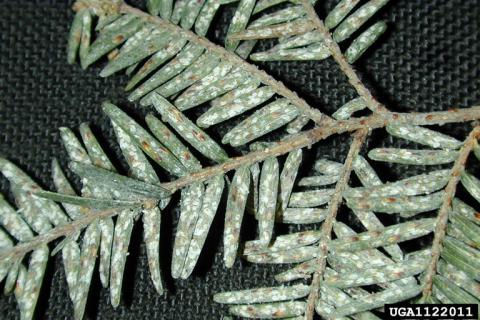Elongate hemlock scale (EHS) is native to Japan. It was first observed in Queens, NY in 1908. Today it is found in thirteen states, including New Hampshire.

Eric R. Day, Virginia Polytechnic Institute and State University, Bugwood.org
Like hemlock woolly adelgid, EHS is a sap feeding insect, draining the tree fluids with its piercing sucking mouthparts. However, unlike HWA, which is found feeding on the hemlock twigs, EHS is found on the underside of the needles. Trees infested with EHS often die in 10-20 years.
Outbreaks of elongate hemlock scale often intensify following infestations of hemlock woolly adelgid, drought, or other stresses that weaken trees. Maintaining trees in a healthy condition discourages buildup of this pest.
Biological Control
Biological control agents of EHS consist of a parasitoid wasp (Encarsia citrina), and predator beetles, such as the twice-stabbed ladybeetle, Chilocorus stigma, Microweisea misella, and Cybocephalus nipponicus. Of these biological control agents, Encarsia citrina showed the most promise, however, a mismatch in the activity of the adult wasp and the abundance of the necessary EHS life stage results in a wide range and inconsistent parasitism rates year-to-year, at the detriment of their efficacy in controlling EHS. However inconsistent, E. citrina still offer an important source of mortality of EHS with periodically high (>90%) parasitism rates.
Biological Control in New Hampshire
EHS was first detected in New Hampshire in 2006. In New Hampshire, there is serious concern for the fate of hemlocks hosting infestations of EHS. The New Hampshire Division of Forest and Lands, Forest Health Program has searched infested stands of hemlock to determine if E. citrina is present in NH and to quantify their parasitism rate on EHS. It was found that E. citrina was present at all seven sites sampled from the Connecticut River to the Seacoast, north to the Lakes Region, representing the northern extend of the EHS range in NH. Rates of parasitism averaged 34.9%, with a low of 23.1% and a high of 64.2%. More work in NH is being done to determine the presence of a predator beetle, Cybocephalus nipponicus, which has also been documented to feed on scale and possibly even reduce scale densities. The fact that E. citrina has been found in reasonably good numbers in NH twenty years after the last releases were made in the Mid-Atlantic States is very promising news for control efforts in New England.

Parasitoid wasp E. citrina, Ryan S. Crandall, NH Division of Forests & Lands
NH TOWNS WITH INFESTATIONS - MAP
EHS Basics & What To Do
EHS & Other Exotic Insects
- Susceptibility of Landscape Trees to Invasive Insects
- Help Protect Our Trees -- Exotic Species Fact Sheet
Important EHS Websites



